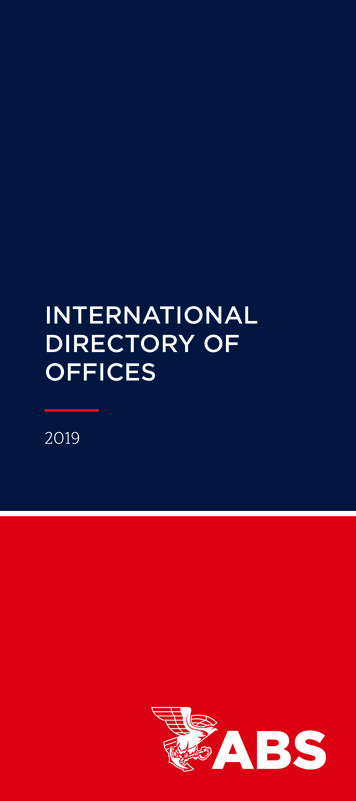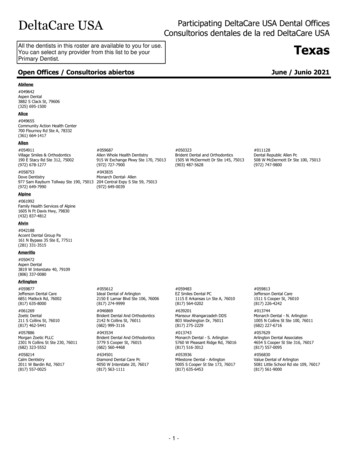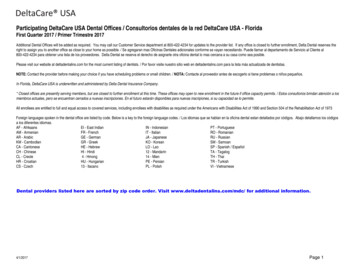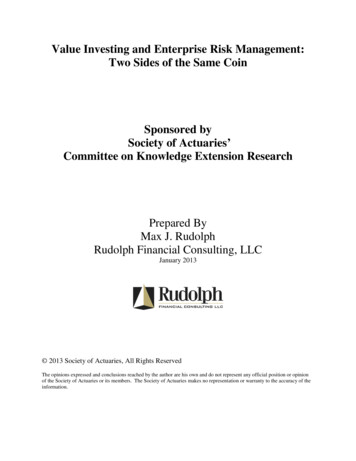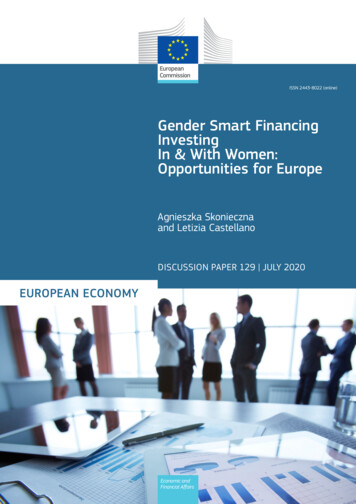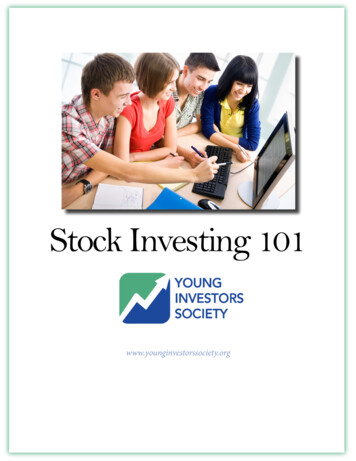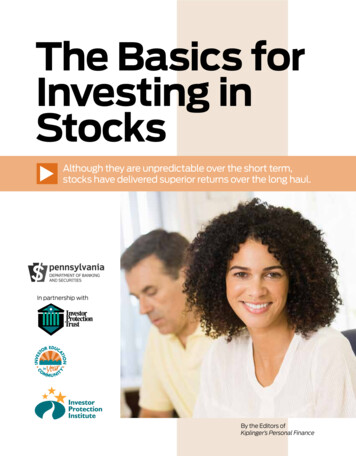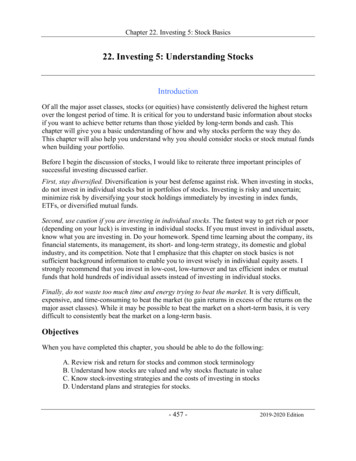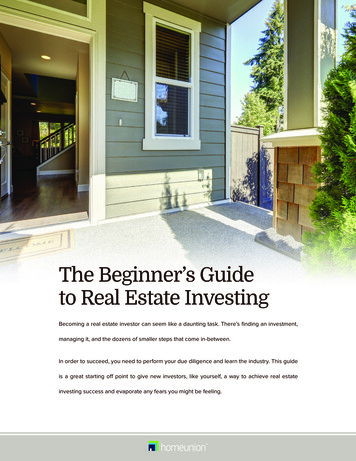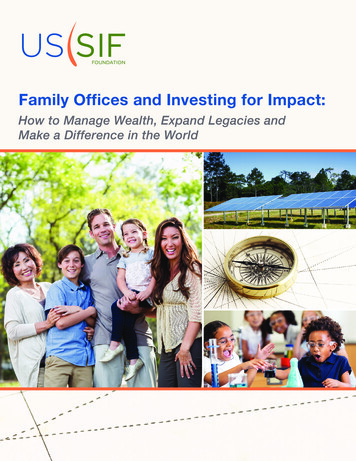
Transcription
Family Offices and Investing for Impact:How to Manage Wealth, Expand Legacies andMake a Difference in the World
Table of ContentsAcknowledgments. 2Executive Summary. 31. Introduction. 42. The Case for Sustainable, Responsible and Impact Investing in Family Offices. 73. Family Offices and Current Trends in Investing for Impact. 124. Recommendations for Moving Forward. 165. Conclusion. 22Appendix 1: Resources for Family Offices. 23Appendix 2: Largest Family Offices in the United States. 25Family Offices and Investing for Impact 1
AcknowledgementsAUTHORFarzana Hoque, US SIF FoundationEDITORMeg Voorhes, US SIF FoundationRESEARCH COMMITTEEMatt AlstedMeredith Benton, Sonen CapitalMolly Betournay, Pathstone Federal StreetSarah Cleveland, Sarah Cleveland ConsultingJustin Conway, Calvert FoundationKimberly Gladman, Just Capital FoundationJoshua Humphreys, Croatan InstituteTimothy Smith, Walden Asset ManagementTom Woelfel, Pacific Community VenturesLisa Woll, US SIF FoundationSPECIAL THANKS TO INTERVIEWEESSusan Babcock, ConsultantAner Ben-Ami, Pi InvestmentsAmy Hart Clyne, Family Office ExchangeJustin Conway, Calvert FoundationAmy Farrell, Privos AdvisoryJames Gifford, Initiative for ResponsibleInvestment at the Harvard Kennedy SchoolMichael Lent, Veris Wealth PartnersKathy Leonard, UBS Financial ServicesThomas Livergood, Family Wealth AllianceJennifer Murtie, Pathstone Federal StreetAbigail Noble, The ImPactAngelo Robles, Family Office AssociationLiesel Pritzker Simmons, Blue Haven InitiativeEric Stephenson, Cordes FoundationJane Swan, Veris Wealth PartnersLoraine Tsavaris, Rockefeller & Co. Inc.Mariela Vargova, Rockefeller & Co. Inc.About the Publisher: The US SIF Foundation, a non-profit 501(c)(3) organization, supports the educationaland research activities of US SIF: The Forum for Sustainable and Responsible Investment (US SIF). US SIFadvances sustainable, responsible and impact investing (SRI). Its members consider environmental, socialand corporate governance criteria to generate long-term competitive financial returns and positive societalimpact. US SIF members include investment management and advisory firms, mutual fund companies,research firms, financial planners and advisors, broker-dealers, community investing organizations, nonprofitassociations, and pension funds, foundations and other asset owners. The US SIF Foundation publishesthe biennial Report on US Sustainable, Responsible and Impact Investing Trends, as well as topical reportson the impact and practice of SRI. The US SIF Foundation operates the Center for Sustainable InvestmentEducation, which produces online and live courses and other educational resources to help advance SRI.Disclaimer: This report is provided only for informational purposes. It does not constitute investment advice.Past performance does not guarantee future results. Investments and strategies discussed herein may notbe suitable for all readers, so readers should consult with financial, legal, tax or accounting professionalsbefore acting upon any information or analysis contained herein. This report does not measure or monitor theperformance of managers or funds. The lists, examples and case studies of investment managers and vehiclespresented in this report should in no way be considered endorsements or investment solicitations. In no wayshould this report be construed as an offer to invest or a form of marketing.2 Family Offices and Investing for Impact
Executive SummaryAbundant anecdotal evidence suggests that a growing number of family offices in the United Statesare exploring ways to invest for impact. This brief guide therefore serves as a resource for familyoffices interested in learning about sustainable, responsible and impact investing (SRI) and reviewstheir unique position within this growing field. To prepare this guide, the US SIF Foundation conducted 16interviews with family offices and other industry professionals and drew on publicly available resources fordata, background information and insights.After a short Introduction that reviews SRI strategies and broad characteristics of family offices, Section 2discusses why family offices choose to practice sustainable, responsible and impact investing. Motivationsinclude the families’ values; financial motivations, including performance return and risk mitigation; and thepositive influence of peers. In addition, the growing availability and variety of SRI investment options areencouraging families to explore investing for impact.Section 3 summarizes the available data on the number of family offices in the United States and theircollective assets under management, which are estimated at 1.7 trillion. Based on US SIF Foundation’sinterviews, however, there is no definitive data on how many of these family offices practice SRI. In 2014,family offices representing 22 billion in assets under management, a relatively small sample, providedinformation for the US SIF Foundation’s biennial survey of SRI trends in the United States; they indicatedthat 1.5 billion of their assets under management took into account environmental, social and corporategovernance factors. This section concludes with brief profiles of nine single family offices and multi-familyoffices, highlighting investment strategies, sectors of interest as well as their motivations for investingfor impact.Section 4 offers recommendations and resources on how to get started in sustainable, responsible andimpact investing across different asset classes. It addresses some of the challenges and perceived barriersmentioned by interviewees. The section provides an overview of various options and common approachesin the SRI product and engagement space, including alternative investments; banks, credit unions and loanfunds; mutual funds and exchange-traded funds; stocks or holdings in public equities (directly owned);and fixed income (direct holdings).Family offices can take a number of steps that will help them move forward with sustainable investmentstrategies: I dentify or appoint a “champion” within the family who is interested in exploring investing for impactand can encourage family members to discuss their goals, values and specific social, environmental orcorporate governance concerns; R eview studies on the financial performance of sustainable investments to compare conventionalinvestments with responsible investments; Engage financial professionals with expertise in sustainable, responsible and impact investing; and T ake advantage of educational resources on sustainable and impact investing, such as online and livecourses, reports, conferences and networks.A summary Conclusion of the report is followed by two appendices. Appendix 1 is a compilation ofresources for family offices, including helpful webpages, courses, publications, networks and conferences.It also provides information on community investing, shareholder engagement and impact measurement.Appendix 2 presents a chart of the largest family offices (multi-family offices and family offices within privatebanks) in the United States.Family Offices and Investing for Impact 3
1. IntroductionFamily offices in the United States have quietly begun to explore and practice investing for impact.Although publicly available data on family offices is limited, anecdotal evidence suggests that familyoffices are making more frequent inquiries to family office membership associations, financial advisors andconsultants about adopting sustainable investment strategies. In addition, a few family offices have publiclyannounced sustainable and impact investments with details such as target sector and investment level.Another indicator of interest in the past year has been the flurry of network events and conference sessionsorganized on this issue for high net worth individuals and family offices.This brief guide serves as a resource for family offices interested in exploring sustainable, responsible andimpact investing (SRI). Practitioners in the industry who serve family offices, including consultants, researchproviders, financial advisors and investment managers, can also benefit from the information and resources inthis paper.Included is background on sustainable, responsible and impact investing in the United States, examplesof current family office involvement and detailed recommendations for family offices on getting started ininvesting for impact.This is a qualitative rather than quantitative study primarily based on 16 interviews conducted by the US SIFFoundation. Interviewees included representatives of single family offices, multi-family offices and familyoffice associations, as well as advisors.WHAT IS SUSTAINABLE, RESPONSIBLE AND IMPACT INVESTING?Throughout the report, “SRI,” “sustainable,” “responsible” and “impact” investing are used interchangeably.Sustainable, responsible and impact investing is an investment discipline that considers environmental,social and corporate governance (ESG) criteria to generate long-term competitive financial returns andpositive societal impact. SRI can be applied across all asset classes. A number of other terms are alsoused for SRI, such as ESG investing, impact investing, values-based investing, mission-aligned investing,socially responsible investing, responsible investing or sustainable investing. Different types of investorsprefer different terms—for example, family offices prefer the terms impact investing or ESG investing andphilanthropic foundations often use the term mission-aligned investing. The term “impact investing” has beenassociated more with investment in private markets where social and environmental performance is activelymeasured. However, the US SIF Foundation utilizes the term “impact investing” as a strategy that can beapplied across all asset classes. While investing for ESG impact can target concessionary returns or marketreturns, this report will focus on the latter.The practice of sustainable, responsible and impact investing is growing in the United States. From 2012to 2014, professionally managed assets engaged in SRI strategies grew from 3.74 trillion to 6.57 trillionto account for one out of every six dollars under professional management in the United States. To learnmore, visit: http://www.ussif.org/trends. Two broad SRI approaches are ESG incorporation and shareholderengagement.ESG incorporation is the consideration of environmental, social and corporate governance criteria ininvestment analysis and portfolio construction across a range of asset classes. An important segment of4 Family Offices and Investing for Impact
ESG incorporation is community investing, which seeks explicitly to finance projects or institutions that willserve poor and underserved communities in the United States and overseas.ESG incorporation can be accomplished in numerous ways: P ositive/best-in-class: Investment in sectors, companies or projects selected for positive ESGperformance relative to industry peers. N egative/exclusionary screening: The exclusion from a fund or plan of certain sectors or companiesbased on specific ESG criteria. E SG integration: The systematic and explicit inclusion by investment managers of ESG factors intotraditional financial analysis. Impact investing: Targeted investments, typically made in private markets, aimed at solving social orenvironmental problems. S ustainability themed investing: The selection of assets specifically related to sustainability in singleor multi-themed funds.Shareholder engagement is the other principal approach for SRI investors. It involves the actionssustainable investors take as asset owners to communicate their concerns to the management of portfoliocompanies about the companies’ ESG policies and to ask management to study these issues, disclosemore information about them and make improvements. Investors can communicate directly with corporatemanagement or through investor networks. For owners of shares in publicly traded companies, shareholderengagement can take the form of filing or co-filing shareholder resolutions on ESG issues and conscientiouslyvoting their shares on ESG issues that are raised at the companies’ annual meetings.To learn more about SRI approaches, see http://www.ussif.org/sribasics.Figure 1: Common ESG IssuesEnvironmentalSocialCorporate GovernanceClean technology, climate change/carbon, green building/smart growth, pollution/toxics, sustainable natural resources/agriculture, waterWorkplace safety, labor relations, workplace benefits,diversity and anti-bias issues, community development,poverty alleviation, human rightsCorporate political contributions, executive compensation,board diversity, anti-corruption policies, board independenceWHAT IS A FAMILY OFFICE?Family offices are private wealth management advisory firms that serve ultra-high net worth families. Incontrast to traditional wealth management firms, family offices provide a complete suite of financial andinvestment services for the family. These can include tax planning, budgeting, insurance, charitable givingand philanthropy, property management, estate planning, and family-owned business
WHAT IS A FAMILY OFFICE? Family offices are private wealth management advisory firms that serve ultra-high net worth families. In contrast to traditional wealth management firms, family offices provide a complete suite of financial and investment services for the family. These can include tax planning, budgeting, insurance, charitable giving

